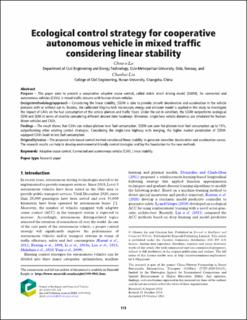Ecological control strategy for cooperative autonomous vehicle in mixed traffic considering linear stability
Peer reviewed, Journal article
Published version
Permanent lenke
https://hdl.handle.net/11250/3035651Utgivelsesdato
2021-11-18Metadata
Vis full innførselSamlinger
Originalversjon
Journal of Intelligent and Connected Vehicles (JICV). 2021, 4 (3), 115-124. https://doi.org/10.1108/JICV-08-2021-0012Sammendrag
Purpose – This paper aims to present a cooperative adaptive cruise control, called stable smart driving model (SSDM), for connected and autonomous vehicles (CAVs) in mixed traffic streams with human-driven vehicles. Design/methodology/approach – Considering the linear stability, SSDM is able to provide smooth deceleration and acceleration in the vehicle platoons with or without cut-in. Besides, the calibrated Virginia tech microscopic energy and emission model is applied in this study to investigate the impact of CAVs on the fuel consumption of the vehicle platoon and traffic flows. Under the cut-in condition, the SSDM outperforms ecological SDM and SDM in terms of stability considering different desired time headways. Moreover, single-lane vehicle dynamics are simulated for humandriven vehicles and CAVs. Findings – The result shows that CAVs can reduce platoon-level fuel consumption. SSDM can save the platoon-level fuel consumption up to 15%, outperforming other existing control strategies. Considering the single-lane highway with merging, the higher market penetration of SSDMequipped CAVs leads to less fuel consumption. Originality/value – The proposed rule-based control method considered linear stability to generate smoother deceleration and acceleration curves. The research results can help to develop environmental-friendly control strategies and lay the foundation for the new methods.

